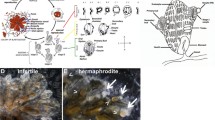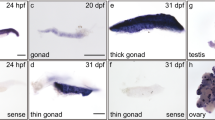Abstract
The gene family DAZ (deleted in Azoospermia), including boule, dazl and DAZ, performs highly conserved functions in germ cell development and fertility across animal phyla. Differential expression patterns have been demonstrated for the family members in invertebrates and vertebrates including fish. Here, we report the identification of boule and dazl and their expression at both RNA and protein levels in developing and mature gonads of Chinese sturgeon (Acipenser sinensis). Firstly, the isolation of the boule and dazl genes in Chinese sturgeon and the observation of the two genes in coelacanth suggest that dazl originated after the divergence of bony fish from cartilaginous fish but before the emergence of the Actinistia. Quantitative real-time PCR and western blot analyses reveal that boule and dazl RNA and proteins are restricted to the testis and ovary. In situ hybridization and fluorescent immunohistochemistry show that the bisexual mitotic and meiotic germ cell expression of dazl RNA and protein is conserved in vertebrates, while Chinese sturgeon boule RNA and protein exhibit mitotic and meiotic expression in the testis, and also likely display mitotic and meiotic expression in female. Moreover, we directly demonstrate for the first time that sturgeon Balbiani body/mitochondrial cloud disperses in the cytoplasm of early developing oocytes and co-localizes with Dazl to some extent. Finally, urbilaterian boule may also have an ancestral function in oogenesis. Taken together, these results provide useful information on the evolution of DAZ family genes, expression patterns and functions in animal reproduction.








Similar content being viewed by others
References
Agulnik AI, Zharkikh A, Boettger-Tong H, Bourgeron T, McElreavey K, Bishop CE (1998) Evolution of the DAZ gene family suggests that Y-linked DAZ plays little, or a limited, role in spermatogenesis but underlines a recent African origin for human populations. Hum Mol Genet 7:1371–1377
Amemiya CT, Alföldi J, Lee AP, Fan S, Philippe H, MacCallum I, Braasch I, Manousaki T, Schneider I, Rohner N (2013) The African coelacanth genome provides insights into tetrapod evolution. Nature 496:311–316
Birstein VJ, Bemis WE, Waldman JR (1997) The threatened status of acipenseriform species: a summary. Environ Biol Fish 48:427–435
Chang P, Torres J, Lewis RA, Mowry KL, Houliston E, King ML (2004) Localization of RNAs to the mitochondrial cloud in Xenopus oocytes through entrapment and association with endoplasmic reticulum. Mol Biol Cell 15:4669–4681
Chen X, Wei Q, Yang D, Zhu Y (2006) Observations on the formation and development of the primary germinal tissue of cultured Chinese sturgeon, Acipenser sinensis. J Appl Ichthyol 22:358
Cooke HJ, Lee M, Kerr S, Ruggiu M (1996) A murine homologue of the human DAZ gene is autosomal and expressed only in male and female gonads. Hum Mol Genet 5:513–516
Eberhart CG, Maines JZ, Wasserman SA (1996) Meiotic cell cycle requirement for a fly homologue of human Deleted in Azoospermia. Nature 381:783–785
Gromoll J, Weinbauer GF, Skaletsky H, Schlatt S, Rocchietti-March M, Page DC, Nieschlag E (1999) The Old World monkey DAZ (Deleted in AZoospermia) gene yields insights into the evolution of the DAZ gene cluster on the human Y chromosome. Hum Mol Genet 8:2017–2024
Houston DW, King ML (2000) A critical role for Xdazl, a germ plasm-localized RNA, in the differentiation of primordial germ cells in Xenopus. Development 127:447–456
Houston DW, Zhang J, Maines JZ, Wasserman SA, King ML (1998) A Xenopus DAZ-like gene encodes an RNA component of germ plasm and is a functional homologue of Drosophila boule. Development 125:171–180
Huang WJ, Lin YW, Hsiao KN, Eilber KS, Salido EC, Yen PH (2008) Restricted expression of the human DAZ protein in premeiotic germ cells. Hum Reprod 23:1280–1289
Johnson AD, Bachvarova RF, Drum M, Masi T (2001) Expression of axolotl DAZL RNA, a marker of germ plasm: widespread maternal RNA and onset of expression in germ cells approaching the gonad. Dev Biol 234:402–415
Karashima T, Sugimoto A, Yamamoto M (2000) Caenorhabditis elegans homologue of the human azoospermia factor DAZ is required for oogenesis but not for spermatogenesis. Development 127:1069–1079
King ML, Messitt TJ, Mowry KL (2005) Putting RNAs in the right place at the right time: RNA localization in the frog oocyte. Biol Cell 97:19–33
Kosaka K, Kawakami K, Sakamoto H, Inoue K (2007) Spatiotemporal localization of germ plasm RNAs during zebrafish oogenesis. Mech Dev 124:279–289
Kuales G, De Mulder K, Glashauser J, Salvenmoser W, Takashima S, Hartenstein V, Berezikov E, Salzburger W, Ladurner P (2011) Boule-like genes regulate male and female gametogenesis in the flatworm Macrostomum lignano. Dev Biol 357:117–132
Lacerda SM, Costa GM, Campos-Junior PH, Segatelli TM, Yazawa R, Takeuchi Y, Morita T, Yoshizaki G, Franca LR (2013) Germ cell transplantation as a potential biotechnological approach to fish reproduction. Fish Physiol Biochem 39:3–11
Li M, Shen Q, Xu H, Wong FM, Cui J, Li Z, Hong N, Wang L, Zhao H, Ma B, Hong Y (2011) Differential conservation and divergence of fertility genes boule and dazl in the rainbow trout. PLoS ONE 6:e15910
Maegawa S, Yasuda K, Inoue K (1999) Maternal mRNA localization of zebrafish DAZ-like gene. Mech Dev 81:223–226
Maruyama R, Endo S, Sugimoto A, Yamamoto M (2005) Caenorhabditis elegans DAZ-1 is expressed in proliferating germ cells and directs proper nuclear organization and cytoplasmic core formation during oogenesis. Dev Biol 277:142–154
Mita K, Yamashita M (2000) Expression of Xenopus Daz-like protein during gametogenesis and embryogenesis. Mech Dev 94:251–255
Peng JX, Xie JL, Zhou L, Hong YH, Gui JF (2009) Evolutionary conservation of Dazl genomic organization and its continuous and dynamic distribution throughout germline development in gynogenetic gibel carp. J Exp Zool B 312:855–871
Reijo RA, Dorfman DM, Slee R, Renshaw AA, Loughlin KR, Cooke H, Page DC (2000) DAZ family proteins exist throughout male germ cell development and transit from nucleus to cytoplasm at meiosis in humans and mice. Biol Reprod 63:1490–1496
Rengaraj D, Zheng YH, Kang KS, Park KJ, Lee BR, Lee SI, Choi JW, Han JY (2010) Conserved expression pattern of chicken DAZL in primordial germ cells and germ-line cells. Theriogenology 74:765–776
Ruggiu M, Speed R, Taggart M, McKay SJ, Kilanowski F, Saunders P, Dorin J, Cooke HJ (1997) The mouse Dazla gene encodes a cytoplasmic protein essential for gametogenesis. Nature 389:73–77
Saxena R, Brown LG, Hawkins T, Alagappan RK, Skaletsky H, Reeve MP, Reijo R, Rozen S, Dinulos MB, Disteche CM, Page DC (1996) The DAZ gene cluster on the human Y chromosome arose from an autosomal gene that was transposed, repeatedly amplified and pruned. Nat Genet 14:292–299
Schmittgen TD, Livak KJ (2008) Analyzing real-time PCR data by the comparative C(T) method. Nat Protoc 3:1101–1108
Seboun E, Barbaux S, Bourgeron T, Nishi S, Agulnik A, Egashira M, Nikkawa N, Bishop C, Fellous M, McElreavey K, Kasahara M (1997) Gene sequence, localization, and evolutionary conservation of DAZLA, a candidate male sterility gene. Genomics 41:227–235
Shah C, Vangompel MJ, Naeem V, Chen Y, Lee T, Angeloni N, Wang Y, Xu EY (2010) Widespread presence of human BOULE homologs among animals and conservation of their ancient reproductive function. PLoS Genet 6:e1001022
Shan Z, Hirschmann P, Seebacher T, Edelmann A, Jauch A, Morell J, Urbitsch P, Vogt PH (1996) A SPGY copy homologous to the mouse gene Dazla and the Drosophila gene boule is autosomal and expressed only in the human male gonad. Hum Mol Genet 5:2005–2011
Slee R, Grimes B, Speed RM, Taggart M, Maguire SM, Ross A, McGill NI, Saunders PT, Cooke HJ (1999) A human DAZ transgene confers partial rescue of the mouse Dazl null phenotype. Proc Natl Acad Sci U S A 96:8040–8045
Thisse C, Thisse B (2008) High-resolution in situ hybridization to whole-mount zebrafish embryos. Nat Protoc 3:59–69
Vangompel MJ, Xu EY (2011) The roles of the DAZ family in spermatogenesis: more than just translation? Spermatogenesis 1:36–46
Vogel T, Speed RM, Ross A, Cooke HJ (2002) Partial rescue of the Dazl knockout mouse by the human DAZL gene. Mol Hum Reprod 8:797–804
Wei Q, Fe K, Zhang J, Zhuang P, Luo J, Zhou R, Yang W (1997) Biology, fisheries, and conservation of sturgeons and paddlefish in China. Environ Biol Fish 48:241–255
Wei QW, Li LX, Du H, Zhang XY, Xiong W, Zhang H, Shen L, Wu JM, Zhang SH, Wang CY, Li CJ, Chai Y, Li XW, Qiao XM, Liu ZG, Gao YP, Gan F (2013) Research on technology for controlled propagation of cultured Chinese sturgeon (Acipenser sinensis). J Fish Sci China 20:1–11 (In Chinese)
Xia W, Zhou L, Yao B, Li CJ, Gui JF (2007) Differential and spermatogenic cell-specific expression of DMRT1 during sex reversal in protogynous hermaphroditic groupers. Mol Cell Endocrinol 263:156–172
Xu EY, Moore FL, Pera RA (2001) A gene family required for human germ cell development evolved from an ancient meiotic gene conserved in metazoans. Proc Natl Acad Sci U S A 98:7414–7419
Xu EY, Lee DF, Klebes A, Turek PJ, Kornberg TB, Reijo Pera RA (2003) Human BOULE gene rescues meiotic defects in infertile flies. Hum Mol Genet 12:169–175
Xu H, Li M, Gui J, Hong Y (2007) Cloning and expression of medaka dazl during embryogenesis and gametogenesis. Gene Expr Patterns 7:332–338
Xu H, Li Z, Li M, Wang L, Hong Y (2009) Boule is present in fish and bisexually expressed in adult and embryonic germ cells of medaka. PLoS ONE 4:e6097
Ye H, Chen X, Wei Q, Zhou L, Liu T, Gui J, Li C, Cao H (2012) Molecular and expression characterization of a nanos1 homologue in Chinese sturgeon, Acipenser sinensis. Gene 511:285–292
Zelazowska M, Kilarski W, Bilinski SM, Podder DD, Kloc M (2007) Balbiani cytoplasm in oocytes of a primitive fish, the sturgeon Acipenser gueldenstaedtii, and its potential homology to the Balbiani body (mitochondrial cloud) of Xenopus laevis oocytes. Cell Tissue Res 329:137–145
Acknowledgments
This work was supported by the National Natural Science Foundation of China (31472286 and 31172413), the National High Technology Research and Development Program of China (2011AA100401) and the National Nonprofit Institute Research Grant of Freshwater Fisheries Research Center, Chinese Academy of Fisheries (2013JBFZ01).
Author information
Authors and Affiliations
Corresponding author
Additional information
Huan Ye and Chuang-Ju Li contributed equally to this work.
Electronic supplementary material
Below is the link to the electronic supplementary material.
Supplementary Fig. 1
(GIF 37 kb)
Supplementary Fig. 2
(GIF 185 kb)
Supplementary Fig. 3
(GIF 189 kb)
Supplementary Fig. 4
(GIF 136 kb)
Rights and permissions
About this article
Cite this article
Ye, H., Li, CJ., Yue, HM. et al. Differential expression of fertility genes boule and dazl in Chinese sturgeon (Acipenser sinensis), a basal fish. Cell Tissue Res 360, 413–425 (2015). https://doi.org/10.1007/s00441-014-2095-2
Received:
Accepted:
Published:
Issue Date:
DOI: https://doi.org/10.1007/s00441-014-2095-2




